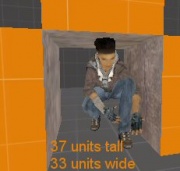| Posts | ||
|---|---|---|
| Help! New to Hammer Editor! | Locked | |
| Thread Options | ||
| Feb 8 2015 Anchor | ||
|
Hey guys, I'm looking into CSGO mapping in Hammer and I've familiarized myself with the basic of the program, but I have a few questions about the conceptual aspect of map design that I'm looking to clear up. 1. Does every map have a skybox, even if the map takes place completely indoors? 2. Would having a skybox make the map design process easier? How do skyboxes affect the map optimization-wise? 3. When building a map with doorways and accessible vents, do I cut through the blocks or do I build everything from the ground up? 4. Are stairs created manually (step by step) or is there a specific stair block? Thanks a ton for reading and answering! |
||
| Feb 10 2015 Anchor | ||
|
First of all good luck with becoming a mapper with Valve's Hammer Editor! Good to see another one aboard I'll try to answer your questions, but I am neither very familiar with outdoor mapping, nor with how some thing are done "right". i just create them my way. I am eager as you to see some of the answers after me. So... 1. No, you do not need a skybox if the map is completely indoors. You'll need to create some boxes with the sky texture in them outside of possible windows though. Good luck with your projects! |
||
| Feb 11 2015 Anchor | ||
|
1. Not every map needs a skybox. Indoor maps could use it if there are lot of windows I guess I just wanted to confirm everything Thanoshld said |
||
| Apr 8 2015 Anchor | ||
|
1. If it takes place indoor there is no need for a sky texture nor a skybox. Though I can think of many levels where it might come in handy. When I was playing ZPS and even some CS levels there are windows where you look outside, but never actually leave the building. Sometimes mappers will create a 3d skybox just for window views but that usually isn't the case for people new to mapping. 2.Skyboxes are great for create a immense 3D experience. I suggest you learn it sooner or later as it makes a level(with an outdoor setting) make look much better. When I was first learning 3D Skyboxes I just created basic rectangle shaped boxes and applied building textures to them to create a city sky-rise look to my level. Highly Recommended for Outdoor. In one map I even created a flying UFO that flew around beaming down into the map. It saved a lot of resources using the skybox. 4. I know in some editors stairs have their own tools. But not in Hammer. The best way to do stairs is def copy and paste. The carve tool is totally useless. I made the mistake of using it when I first started 12 years ago and it did nothing but screw me up. So just forget it even exists. The best way to do vents is to line up brushes. The best tip for that is to make sure your wall widths are the same size as to make sure things line up properly and try to stick to the grid. It's easy to get off the grid and once you do everything starts to get ...... messy. This link should help you with making sure your vents/stairs/doors are all at proper sizes. I hope all this info helped and wish you good luck in mapping. Don't forget to come back and show us some of your work when your done! Developer.valvesoftware.com 1 = 0.75" = 19.05mm Player Collision Hull Player Eyelevel Architecture |
||
Only registered members can share their thoughts. So come on! Join the community today (totally free - or sign in with your social account on the right) and join in the conversation.


